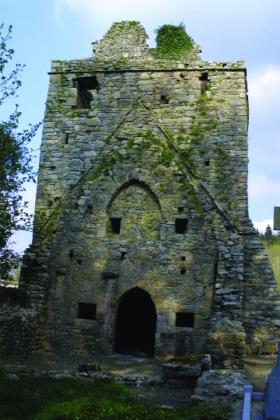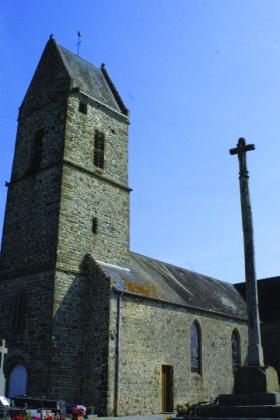Defending the sacred: from Crac de Chevalier to Aghavillier—a common thread
Published in Features, Issue 6 (Nov/Dec 2007), Medieval History (pre-1500), Volume 15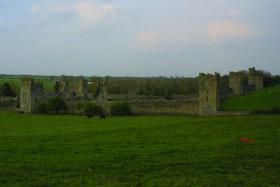
Pl.1—A view of Kells Priory, Co. Kilkenny. This house was founded by Geoffrey fitz Robert in 1183. He was a follower of William Marshal, who is mentioned in the dedication. Marshal died in the habit of a Templar and is buried in the Temple Church in London. (L. Doran)
For Irish people the archetype of a fortified religious building is best encapsulated by the spectacular Augustinian priory at Kells, Co. Kilkenny (Pl. 1), the more ruinous but equally emotive remains of the Augustinian house at Athassel, Co. Tipperary, with its impressive defended gatehouse, or the dramatic fortified ruins of Lindisfarne priory on the Northumbrian coast. These buildings recall scenes from the Ridley Scott film Kingdom of Heaven, featuring the fabled Crac de Chevalier (Pl. 2). Indeed, a recognisable romantic ‘crusader’ tradition is evoked by even the more common simple defended stone churches—a similarity in symbolism with the conventional castle of Cesis in Latvia (Pl. 3). This fortress was occupied by a small military order of warrior monks—later united with the Teutonic Knights—who were the first to defend Christian missions amongst German merchant settlements along the River Dvina, the sort of group you would expect to build or defend a religious house. In fact, Kells, Athassel or Cecis represent only a strand—albeit the most glamorous—in the various categories of fortified religious buildings here and elsewhere. The importance of their role in the social life and architectural development of later medieval Ireland is at once simpler and more fundamental.
Sentries on the landscape
Through time there has been a connection between fortification and religious buildings. In Ireland the tradition is typified by the monastery of Glendalough, with its round tower, and by the ecclesiastical rock edifice at Cashel. The securing of a building or space fulfilled a variety of functions. Defence was the obvious one, but image was everything at a time when few people could read: power was demonstrated by the control and display of possessions indicating authority. All power, whether spiritual, economic, military or political, is specified by demonstration (a fact well understood by the planners of the US invasion of Iraq, whose tactics were designed to ‘shock and awe’). In the case of fortified religious houses this ‘awe’ was mingled with a sacred consciousness. When rounding the bend of the road just as the Rock of Cashel comes into view or seeing, across the top of the surrounding trees, the projection of the round tower at Glendalough one is still acutely aware of this power to awe. Round towers—an architectural device echoed across the world, for example by the minarets of Tunisia—while not strictly defensive elements nevertheless were sentries on the
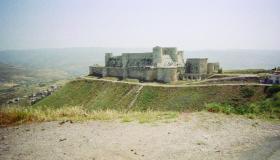
Pl. 2—Crac de Chevalier, Syria. The fabled Templar site is most people’s idea of a fortified religious house. (O. Gormley)
landscape: a warning that one is approaching a site of great consequence and that one’s approach is noted.
For the medieval period the most numerous and most important fortified religious structures were the parish churches. The similarity between fortified hall-houses, such as Coolhull, Co. Wexford, and the defended churches at Taghmon, Co. Westmeath (Pl. 4), and Newtown Arlosh, Cumbria (Pl. 5), is obvious. Equally there is a common architectural tradition between the defended churches at Rhossili, Gower in Wales, and the church at La Ronde-Haye in Normandy (Pl. 6), for example, and early hall-houses, such as Oldcourt and Kindlestown, Co. Wicklow, exemplified by their slender towers. These buildings are part of an architectural milieu that includes St John the Baptist, Burgh-by-Sands, and Great Salkeld (Cumbria), Sigginstown (Co. Wexford), Straffan, Leixlip and Maynooth (Co. Kildare), Ardmayle and Kiltinan (Co. Tipperary) and various churches and castles of Gower (Wales).
For many rural farming neighbourhoods, the undocumented churches whose ruins are scattered across the Irish countryside were the centres of their communities. Some of these are parish churches with recorded histories, even if it is only as a taxation statistic, but most have none. For their parishioners, however, they were not only houses of worship: they were the places where people gathered in time of trouble, a safe haven for refugees and a secure location for precious items. At a time when most buildings were constructed of timber, stone-built churches offered protection not only from thieves but also from fire. Both Irish and Anglo-Norman sources contain many references to the practice of depositing items of value in churches. In 881 the Chronicum Scotorum notes that ‘The oratory of Cianan [Duleek] was broken into by the Foreigners, and its fill of property taken out of it’. In 949 the Annals of the Four Masters tell us that Godfrey, son of Sitric, raided a number of churches in Meath and took away, besides people into slavery, gold, silver, raiment and ‘various wealth of every description’. Perhaps one of the most instructive references is that in the Calendar of Justiciary Rolls for 1311 concerning thefts from the church of St Michael in Athy. Here we have at least eight private individuals with chests deposited in the church containing a variety of perishable and non-perishable items, including woollen cloth, sheets, garments, thread, bacon, beans and money. In 1420 the Annals of Connacht record that two brothers went to the church of Odelb, near Tulsk, Co. Roscommon, ‘to fetch some armour that was in the church’. Armour—a rare and valuable possession—had been placed in the church for protection, to be retrieved when the need arose.
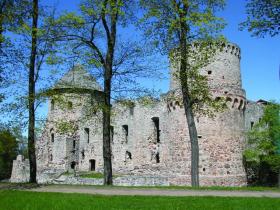
Pl. 3—Cesis Castle, Latvia. This conventual castle was established by the Brethren of the Sword, a military order formed to protect German missionaries. (Latvian Consular Service)
Like local parish churches, monasteries also provided this form of safekeeping for their tenants and the surrounding population. In 1308 at Limerick Brother Isaac complained to the justiciar that William, late abbot of the house, had broken into the abbey on two occasions, the first time stealing money from a chest and the second carrying away ‘the goods and chattels of the men and tenants of the abbot’. The negative consequences of this service to the local community are illustrated by the fate of the church at Birr. In 1214 the Annals of Loch Cé record that ‘Cormac, son of Art, went to the castle of Birr, and burned its bawn, and burned the entire church, and took all the food out of it, in order that the Foreigners of the castle should not get food in it’. It is interesting to note that the food was stored not in the castle but in the church. The problem became so acute that one can trace efforts on the part of the authorities to deal with it. In 1197 the Annals of Ulster detail the hanging of Mac Gilla-Eidich of the Ciannachta for stealing from the church in Derry. In 1317, at a synod in Kilkenny, Bishop de Ledred—famous for his pursuit of Alice Kytler as a witch—inserted in the instrument of government for the diocese of Ossory the provision against ‘those who . . . plunder goods deposited therein [churches] for safety . . . shall ipso facto incur the greater excommunication’.
The association of souterrains with church sites in Ireland and elsewhere is another indication of the role of the local church or religious house as a safe haven in time of upheaval. It was as an extension of their role as a place of sanctuary that churches may have been defended. The fortification of ecclesiastical buildings on the Scottish–English border in the fourteenth century in response to an increase in political and military turmoil is a case in point. In Ireland, to date, souterrains have been linked with the enclosure or environs of the church rather than the building. In France, however, souterrains occur in direct association with churches. A late example is seen at Petosse in Vendée; this was built towards the end of the sixteenth century and is entered directly from the nave of the church. It was almost certainly constructed on the rebuilding of the church following its sacking by Calvinist forces in 1562. In general, fortified ecclesiastical buildings are found throughout France, apparently a response to the unsettled conditions of the Hundred Years’ War. While in Ireland we lack the direct association of a church and souterrain, the presence of souterrains in close proximity to churches nevertheless suggests a link between a defended place of safety and the traditional refuges for the community in times of disorder.
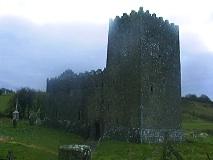
4—Taghmon, Co. Westmeath. The similarities of buildings such as this to domestic hall-houses underlines the common architectural tradition. (W. Doran)
In the medieval period many churches and religious houses were closely identified with a local ruling family, frequently having a member as head of the foundation. The Cistercian house at Abbeylara, Co. Longford, is a good example. Founded in 1214 by Richard de Tuit, close to the caput of his manor at Granard, the abbey was a daughter-house of St Mary’s, Dublin. By the early fourteenth century Abbeylara, reflecting political and social realities on the ground, had become closely identified with Ó Fearghail, the principal Gaelic family of the region. A consequence of this identification of churches or religious foundations with particular groups or families was that they were perceived to be part of the political infrastructure of a territory. Even the accidental involvement of churches in war could result in their being viewed in this manner by the protagonists. In c. 1116 the Welsh chronicle Brut y Tywysogyn notes an incident that illustrates just such an episode. In a conflict principally between Gruffudd ap Rhys and Gilbert fitz Richard the church of Padarn, close to the castle of Gilbert’s steward, was attacked: ‘They committed a sacrilege in the church, taking cattle from the church as food for themselves’. During hostilities churches and religious houses were places where the wealth of the community, in addition to refugees, was located. An army on the march needed food, and booty was a dissipation of the enemy’s resources. In such a climate it was a short step to the realisation that churches and religious buildings were elements of vital infrastructure that needed to be defended.
In Wales, England and Scotland fortified religious houses, including small parish churches, have a particular concentration in the marches, notably those of northern England and along the Welsh border. Some Irish examples, such as Taghmon, Co. Westmeath, Aghavillier, Co. Kilkenny (Pl. 7), Errill, Co. Laois, and Leigh, Co. Tipperary, are located in regions that were frontiers at periods during the Middle Ages. Since there has been no national survey of such structures in Ireland it is unclear whether this is a true reflection of an island-wide distribution. It is possible that in Ireland the distribution may more closely resemble that of France. The role of the parish church as a place of sanctuary and of safekeeping is well recorded, as we have seen. In addition, fortified priories and abbeys were used as bases for troops and campaign provisions.
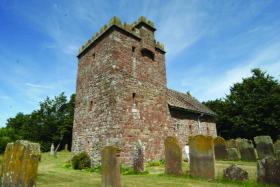
Pl. 5—Newtown Arlosh, Cumbria. Similar in style to Taghmon and other Irish fortified churches and houses, its border location is echoed in churches such as Aghavillier, Co. Kilkenny. (W. Doran)
A common architectural tradition is evident in Irish hall-houses, tower-houses and fortified church towers and some French secular and church towers. This has appealing implications for the dating and origins of Irish tower-houses. Many of the churches in France, northern England and Wales with which tower-houses share design features have documented dating evidence largely lacking for Irish hall-houses and tower-houses. Tom McNeill has noted that there are no overall criteria for distinguishing between the building work of 1350–1450 and that of 1450–1550. The architecture of English and French fortified churches and castles may contribute to the discussion on tower-house dating. Churches such as Burgh-by-Sands, Newton Arlosh and Great Salkeld in Cumbria have fortified towers dating from the late thirteenth or early fourteenth century—a date that would bridge the fourteenth-century building hiatus suggested by H. G. Leask. Others, for example Ancroft and Edlingham in Northumbria with their later fourteenth-century ‘peel’ towers, offer comparison with Aghavillier or the earlier phase of Monkstown Castle, Co. Dublin. Charles Coulson has pointed to a tendency on the part of archaeologists and historians to separate the architecture of castles from that of ecclesiastical buildings. This introduces a division that would not have been recognised by medieval architects and craftsmen. It is clear that the fortification of towns, such as Clonmel and Youghal, for instance, was part of the same building milieu as the fortification of their churches and the building of urban tower-houses.
While the defensive element of these fortified religious buildings has been stressed, it is likely that much of the fortification was related to prestige. Undoubtedly, the primary










